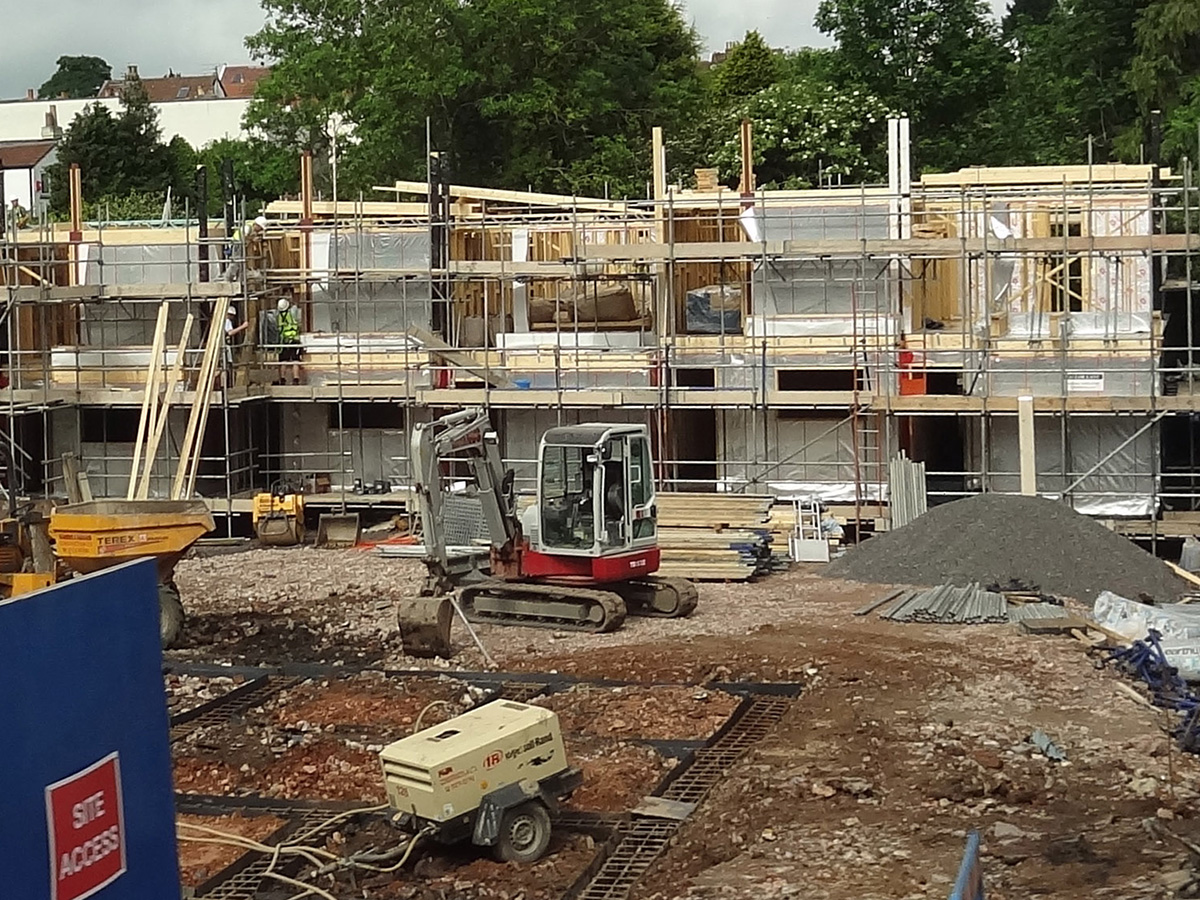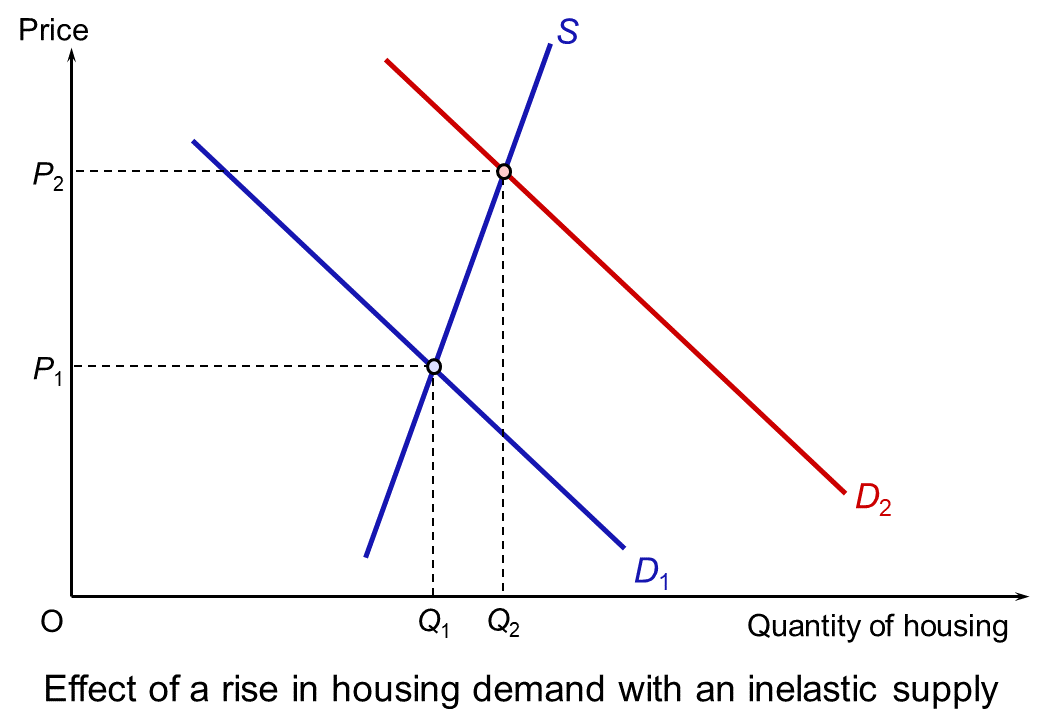 House prices are soaring throughout the world, making them unaffordable for many first-time buyers. In the UK, for example, according to the Nationwide, the annual house price increase was 13.4% in 2021 Q2. In the USA, house prices are rising by over 23% per annum.
House prices are soaring throughout the world, making them unaffordable for many first-time buyers. In the UK, for example, according to the Nationwide, the annual house price increase was 13.4% in 2021 Q2. In the USA, house prices are rising by over 23% per annum.
The reason for this rampant house price inflation is that demand is rising much faster than supply. What is more, with inelastic supply in the short term, a given percentage rise in demand leads to a larger percentage increase in prices.
Reasons for rapidly rising house prices
 But why has demand risen so rapidly? One major reason is that central banks have engaged in massive quantitative easing. This has driven down interest rates to historic lows and has led to huge asset purchases. Mortgage lenders, awash with money, have been able to increase the ratio of lending to income. Borrowing by house purchasers, encouraged by low interest rates and easy access to mortgages, has thus increased rapidly.
But why has demand risen so rapidly? One major reason is that central banks have engaged in massive quantitative easing. This has driven down interest rates to historic lows and has led to huge asset purchases. Mortgage lenders, awash with money, have been able to increase the ratio of lending to income. Borrowing by house purchasers, encouraged by low interest rates and easy access to mortgages, has thus increased rapidly.
Another reason for the increased demand is that economies are beginning to recover from the COVID-induced recessions. This makes people more confident about their future financial positions and more willing to take on increased mortgage debt. Another reason is that, with increased working from home, people are looking for larger houses where rooms can be used as studies. Another is that, with less spending during the lockdowns, people have built up savings, which can be used to buy larger homes.
Some countries have deliberately boosted demand by fiscal measures. In the UK, the government introduced a stamp duty ‘holiday’. Previously a 3% ‘stamp duty’ tax was applied to purchases over £125 000. Under the holiday scheme, the rate would only apply to purchases over £500 000 until 30 June 2021 and then to purchases over £250 000 until 30 September 2021. This massively boosted demand, especially as the deadlines approached. In the USA, there are various schemes at federal and state level to support first-time buyers, including low-interest loans and vouchers. Supporting demand is counterproductive if it merely leads to higher prices and thus does not make it easier for people to buy.
Speculation has played a major part too, with many potential purchasers keen to buy before prices rise further. On the supply side, some vendors have held back hoping to get a higher price by waiting. Gazumping has returned. This is where vendors accept a new higher offer even though they have already accepted a previous lower one.
Effects of higher house prices
Higher house prices have had a knock-on effect on rents, which have also soared. This has encouraged house purchases for rent both by individuals and by property investment companies. The effect of rapidly rising house prices and rents has been to increase the divide in society between property owners and those unable to afford to buy and forced to rent.
Increased housing wealth is likely to lead to greater housing equity withdrawal. This is where people draw on some of their equity in order to finance increased consumer spending, thereby boosting aggregate demand and possibly inflation.
Will the house price boom end soon?
 One scenario is that there will be a gradual slowdown in house price increases as quantitative easing is tapered off and as support measures, such as the UK’s stamp duty holiday, are unwound.
One scenario is that there will be a gradual slowdown in house price increases as quantitative easing is tapered off and as support measures, such as the UK’s stamp duty holiday, are unwound.
There is a real possibility, however, that there will be a more severe correction, with house prices actually falling. This could be triggered by central banks raising interest rates in response to higher inflation caused by the recovery and by higher commodity prices. In the UK, labour shortages brought about by Brexit could make the inflationary problem worse. With high levels of mortgage debt, even a half percentage point rise in mortgage interest rates could have a severe effect on demand. Falling house prices will then be compounded by speculation, with buyers holding off and sellers rushing to sell.
Articles
- “UK Boom the Biggest in 50 years” thanks to House Prices, but Oxford Economics Warn of Risks
PoundSterling Live, Gary Howes (18/6/21)
- US house prices see biggest rise in 30 YEARS and are outstripping Britain’s pandemic-fuelled boom: Is a global housing market bubble emerging?
This is Money, Helen Crane (1/7/21)
- House prices: urban exodus of upsizers shifts property demand
Business Telegraph (18/4/21)
- House prices rise at fastest pace in 17 years
BBC News (30/6/21)
- Runaway house prices: the ‘winners and losers’ from the pandemic
Financial Times, Delphine Strauss and Colby Smith (25/6/21)
- World’s Bubbliest Housing Markets Flash 2008 Style Warnings
Bloomberg, Enda Curran (15/6/21)
- House prices climb to record levels in US and Europe
Financial Times, Martin Arnold, Colby Smith and Matthew Rocco (22/6/21)
- With house prices through the roof, young buyers’ hopes go out the window
The Observer, Phillip Inman (3/7/21)
- Is the UK housing bubble about to burst? These are the best and worst scenarios
The Guardian, Josh Ryan-Collins (2/7/21)
- House prices: the risks of a fall are higher than most people think
The Conversation, Geoff Meen (28/6/21)
Data
Questions
- Use a supply and demand diagram to illustrate what has been happening to house prices. Illustrate the importance of the price elasticity of supply in the process.
- Under what circumstances might tax relief help or not help first-time buyers?
- Use a supply and demand diagram to illustrate the effect of speculation on house prices? Under what circumstances might speculation (a) make the market less stable; (b) help to stabilise the market?
- Explain what is meant by housing equity withdrawal. Using the Bank of England website, find out what has happened to housing equity withdrawal in the UK over the past 15 years. Explain.
- Under what circumstances would a sudden house price correction be more likely?
- Write a critique of housing policy in the light of growing inter-generational inequality of wealth.
 For the majority of people, a house (or flat) is the most valuable thing they will ever own.
For the majority of people, a house (or flat) is the most valuable thing they will ever own.
It is important to understand the role that house prices play in the economy and how much of an impact they have.
The Bank of England monitors changes in the housing market to assess the risks to the financial system and the wider economy. The housing market employs large numbers of people in construction, sales, furniture and fittings, and accounts for a sizeable percentage of the value of GDP. The market is closely linked to consumer spending and therefore is a crucially important sector of the economy.
The concepts of supply and demand can be applied to understand house price changes and the impacts on the economy.
What is the housing market?
The housing market brings together different stakeholders, such as homeowners who are selling their properties, people seeking to buy a property, renters, investors who buy and sell properties solely for investment purposes, contractors, renovators and estate agents, who act as facilitators in the process of buying or selling a property.
In the UK, two-thirds of households own the property in which they live, and the remaining third of households are renters, split fairly equally between private and social renting. We can thus divide people into:
- Homeowners – either outright owners or with a mortgage;
- Private renters – people renting from private landlords;
- Social renters – people renting from local authorities and housing associations.
There are many determinants of demand and supply in the housing market, many of which are related to demographic factors. Such factors include the size of the market, rate of marriages, divorces, and deaths. However, factors such as income, availability of credit, interest rates and consumer preferences are also important.
Why is the housing market important for the economy?
 Changes in the housing market are always given such importance due to the relationship house prices have with consumer spending. Changes in house prices and the number of sales affect how much money people have to spend. Given that household spending accounts for two-thirds of Britain’s total economic activity, any changes in consumption is likely to have a major impact on the wider economy. Observing the housing market helps us to assess the overall demand for goods and services.
Changes in the housing market are always given such importance due to the relationship house prices have with consumer spending. Changes in house prices and the number of sales affect how much money people have to spend. Given that household spending accounts for two-thirds of Britain’s total economic activity, any changes in consumption is likely to have a major impact on the wider economy. Observing the housing market helps us to assess the overall demand for goods and services.
When house prices increase, those consumers who own their own homes have now become better off as their houses are worth more. This ‘wealth effect’ increases the confidence of homeowners, which in turn increases consumption. Some of these homeowners will decide to acquire additional borrowing against the value of their home. The borrowing is then spent in the economy on goods and services, thereby increasing aggregate demand and GDP.
However, when house prices decline, homeowners lose confidence as their home is now worth less than before. This becomes a major issue if prices have decreased enough to make their house worth less than the remainder of the unpaid mortgage – known as ‘negative equity’. Homeowners will therefore reduce their consumption and will be less likely to undertake any new borrowing.
The vast majority of homeowners will have taken out a mortgage in order to purchase their home. Mortgages are the largest source of debt for households in the UK. More than 70% of household borrowing is mortgage debt. Half of all homeowners who live in the house they own are still paying off their mortgage. Therefore, households might suddenly hold back on their spending during times of uncertainty because they start to worry about repaying their debts. This has a knock-on effect on the rest of economy, and a small problem can suddenly become a big one.
In addition to affecting overall household spending, the buying and selling of houses also affects the economy directly. Housing investment is a small but unpredictable part of total output in the economy. There are two different ways in which the buying and selling of houses impacts GDP.
 The first is when a new build is purchased. This directly contributes to GDP through the investment in the land to build the house on, the purchase of materials and the creation of jobs. Once the homeowners move in they also contribute to the local economy: i.e. shopping at local shops.
The first is when a new build is purchased. This directly contributes to GDP through the investment in the land to build the house on, the purchase of materials and the creation of jobs. Once the homeowners move in they also contribute to the local economy: i.e. shopping at local shops.
The second is when an existing home is bought or sold. The purchase of an existing home does not have the same impact on GDP. However, it does still contribute to GDP: i.e. from estate agents’ and solicitors’ fees and removal costs to the purchase of new furniture.
Why house prices change: demand and supply
Demand: the demand for housing can be defined as the quantity of properties that homebuyers are willing and able to buy at a given price in a given time period. Factors affecting the demand for housing include:
- Real incomes: If real incomes increase the demand for housing increases due to a rise in the standard of living.
- The cost of a mortgage: If there is a rise in interest rates in the economy, mortgage interest rates are likely to rise too. This makes the cost of financing a loan more expensive and therefore will see a decline in demand.
- Availability of credit: The more lending banks and building societies are willing to provide, the more people will borrow and spend on housing and hence the higher house prices will be.
- Economic growth: When the economy is in the recovery and boom stages of the business cycle, wages rise. This will increase the demand for houses.
- Population: When the population increases or if there is an increase in single-person households, demand for housing increases.
- Employment/unemployment: The higher the level of unemployment in an economy, the less people will able to afford housing.
- Confidence: If consumers feel optimistic about the future state of the economy, they will be more likely to go ahead with purchasing a house, thereby increasing demand. House prices tend to rise if people expect to be richer in the future.
Supply: The supply of housing can be defined as the flow of properties available at a given price in a given time period. The supply of housing includes both new-build homes and existing properties. Factors affecting the supply for housing include:
- Costs of production: The higher the cost of production, the fewer houses are built, reducing the supply of housese coming to the market. Example of costs include: labour costs, land for development and building materials.
- Government policy: If the government increases taxation and/or reduces subsidies for new house developments, there will be fewer new houses built.
- Number of construction companies: Depending on their objectives, the more construction companies there are, the more likely there is to be an increase in the supply of housing. The construction industry accounts for around 7% of UK GDP.
- Technology and innovation: With improved technology and innovation in the construction industry, houses become cheaper and easier to build, thus increasing the supply.
- Government spending on building new social housing: The government has the ability to influence the supply of housing by increasing spending on new social housing.
Price elasticity of supply
 The supply of new housing in the short run is price inelastic. The main reason for this is the time it takes to build a new home. The production of a house can take many months, from the planning process to the project’s completion. Supply also relies on access to a skilled labour force and the availability of certain construction materials.
The supply of new housing in the short run is price inelastic. The main reason for this is the time it takes to build a new home. The production of a house can take many months, from the planning process to the project’s completion. Supply also relies on access to a skilled labour force and the availability of certain construction materials.
Because of the inelastic supply, any changes in demand are likely to have a significant effect on price. This is illustrated by the diagram, which shows a larger proportionate increase in price than quantity when demand increases from D1 to D2.
The current UK housing market
Despite the current economic climate and the effects of the lockdown restrictions on consumers, house prices have increased, and sales have now resumed. Rightmove, which advertises 95% of homes for sale, states that the housing market has seen its busiest month in more than 10 years in July. During the summer, the housing market usually sees a lull in activity. However, since the easing of lockdown, there has been a flurry of activity from buyers and sellers. Since July 2019, house prices have increased by 1.7%, according to the Nationwide Building Society.
 London estate agency, Hamptons, states that homeowners are now bringing forward their moving plans as the experience of lockdown has encouraged them to seek more space. The mortgage market is also very favourable right now in terms of interest rates, and rental demand is continuing to surge across the UK.
London estate agency, Hamptons, states that homeowners are now bringing forward their moving plans as the experience of lockdown has encouraged them to seek more space. The mortgage market is also very favourable right now in terms of interest rates, and rental demand is continuing to surge across the UK.
The increase in activity in the market has also been helped by the announcement of a stamp duty ‘holiday’ until March 2021. This sees the threshold above which stamp duty is paid rising from £125 000 to £500 000. Estate agency, Savills, has also seen an increase in the number of new buyers registering with its service, more than double the number registered in July 2019. It is thought that, along with the tax savings from stamp duty, people’s experiences in lockdown have made them evaluate their current living space and reconsider their housing needs.
However, given the that the economy is experiencing its deepest recession on record, there is concern about just how long the market can resist the economic forces pulling prices down.
Historically, a drop in house prices has been both a cause and a consequence of economic recessions. During the 2008 financial crisis, house prices fell by about 30%. As previously mentioned, for the majority of people, a house is the most valuable thing they will ever own and therefore consumers are extremely interested in its value. Consumer confidence is one of the key factors affecting the demand for housing. If consumers feel pessimistic about the future state of the economy, they will be less likely to go ahead with purchasing a house, thereby decreasing demand. Britain’s Office for Budget Responsibility, the country’s fiscal watchdog, forecasts that during this downturn prices will fall 5% this year and 11% in 2021.
Various government schemes put in place to help during lockdown are starting to come to an end. The main one – the furlough scheme, which replaced 80% of eligible workers’ incomes – comes to an end in October. It is forecast that labour market conditions will weaken significantly in the quarters ahead, with unemployment predicted to rise for the rest of the year. If these predictions materialise, it would likely dampen housing activity once again.
Conclusion
Fluctuations in house prices and transactions tend to amplify the volatility of the economic cycle. Therefore, it is crucial that we understand what influences such changes. Understanding how supply and demand factors influence the housing market can enable key stakeholders to make better predictions about future activity and plan accordingly. The current market has seen a growth since the easing of restrictions but there is concern that this has been powered by pent-up demand. Therefore, the outlook for house prices is uncertain and the full effects of an economic downturn are yet to be realised.
Articles
Questions
- Explain why the supply of housing is inelastic in the short-term.
- Given that the elasticity of housing supply in the UK is low, what policies could be introduced to ensure that house building is more responsive to changes in market demand?
- If unemployment does increase as predicted, explain what impact this would have on the demand in the housing market and house prices? Use a supply and demand diagram to aid your answer.
- Explain how changes in house prices affect the government’s key macroeconomic objectives.
 Young people are increasingly finding it impossible to buy their own home. The reasons are easy to find: income rises of young people have failed to match rises in house prices, and access to loans has become more restrictive since the financial crisis. In 2002, 58.6% of 25-34 year-olds owned their own home; today, the figure is just 36.7%.
Young people are increasingly finding it impossible to buy their own home. The reasons are easy to find: income rises of young people have failed to match rises in house prices, and access to loans has become more restrictive since the financial crisis. In 2002, 58.6% of 25-34 year-olds owned their own home; today, the figure is just 36.7%.
Conventional wisdom is that the source of the problem is on the supply side: a lack of house building. But according to the Redfern Review, led by the chief executive of Taylor Wimpey, Pete Redfern, the source of the problem lies mainly on the demand side. Overall demand for housing has been rapidly rising, stoked by low interest rates and the Help to Buy scheme, which is available to existing home owners as well as first-time buyers. However, purchases by first-time buyers have fallen as their incomes have declined relative to those of older people.
Of course, increasing supply, especially of cheaper starter homes, would help young people, but, according to the Redfern Review, such schemes take a long time to make much of a difference (although building modular homes could be much quicker). In the meantime, help could be provided on the demand side by making the Help to Buy scheme available only to first-time buyers and by increasing the help to them provided under the scheme, and also by encouraging lenders to make access to mortgages easier.
by increasing the help to them provided under the scheme, and also by encouraging lenders to make access to mortgages easier.
But a problem for most young people is high levels of debt, including student loans. Such debt and a lack of savings makes it difficult to raise a deposit, let alone afford mortgage repayments. And on the rental side, accommodation is becoming less and less affordable as rents rise faster than incomes, further exacerbating the difficulty of clawing down debt and saving for a deposit.
A long-term solution must involve increased supply – as the Redfern Review recognises. But in the short-term, providing more help to first-time buyers and those paying high rents could make a significant difference.
Webcast
 Tackling UK housing crisis ‘will take generations’ ITV News, Joel Hills (16/11/16)
Tackling UK housing crisis ‘will take generations’ ITV News, Joel Hills (16/11/16)
Articles
Review of home ownership in UK shows severe decline in young buyers PropertyWire (16/11/16)
Housing crisis: Lack of new building not to blame for soaring house prices finds Labour-commissioned report Independent, Ben Chu and Ashley Cowburn (16/11/16)
Redfern Review: Focus on First Time Buyers and Launch Housing Commission Money Expert, Danny Lord (16/11/16)
First-time buyers need more help, review finds BBC News (16/11/16)
Redfern Review echoes Homes for Scotland’s call for joined-up approach to housing Scottish Housing News, Nicola Barclay (17/11/16)
Redfern review into housing: worth building on? The Guardian, Nils Pratley (15/11/16)
UK housing review downplays developers’ role in crisis, critics say The Guardian, Graham Ruddick (16/11/16)
Report
The Redfern Review into the decline of homeownership (16/11/16)
Data
Economic Data freely available online: UK house prices The Economics Network
UK House Price to income ratio and affordability Economics Help blog (21/9/15)
House Price Index Nationwide
UK House Price Index: reports ONS/Land Registry
House Price Index: Statistical Bulletin ONS (Sept. 2016)
Questions
- Do a data search to find out what has happened since 1990 to (a) average UK house prices; (b) average incomes; (c) the distribution of income since 1990; (d) first-time buyer affordability of houses.
- Use a supply and demand diagram to illustrate current average house prices compared with house prices in 2000.
- How does the price elasticity of supply of houses affect the impact of a rise in demand on house prices? Illustrate your answer with a diagram.
- What determines the price elasticity of supply of houses?
- What particular problems do young people face in being able to afford to buy a house or flat?
- How would making it easier for young people to be able to raise finance to purchase their first home affect the price of starter homes?
- What policies could be adopted by the government to make rents more affordable? Discuss the advantages and disadvantages of such policies.
 House prices are soaring throughout the world, making them unaffordable for many first-time buyers. In the UK, for example, according to the Nationwide, the annual house price increase was 13.4% in 2021 Q2. In the USA, house prices are rising by over 23% per annum.
House prices are soaring throughout the world, making them unaffordable for many first-time buyers. In the UK, for example, according to the Nationwide, the annual house price increase was 13.4% in 2021 Q2. In the USA, house prices are rising by over 23% per annum.  But why has demand risen so rapidly? One major reason is that central banks have engaged in massive quantitative easing. This has driven down interest rates to historic lows and has led to huge asset purchases. Mortgage lenders, awash with money, have been able to increase the ratio of lending to income. Borrowing by house purchasers, encouraged by low interest rates and easy access to mortgages, has thus increased rapidly.
But why has demand risen so rapidly? One major reason is that central banks have engaged in massive quantitative easing. This has driven down interest rates to historic lows and has led to huge asset purchases. Mortgage lenders, awash with money, have been able to increase the ratio of lending to income. Borrowing by house purchasers, encouraged by low interest rates and easy access to mortgages, has thus increased rapidly.  One scenario is that there will be a gradual slowdown in house price increases as quantitative easing is tapered off and as support measures, such as the UK’s stamp duty holiday, are unwound.
One scenario is that there will be a gradual slowdown in house price increases as quantitative easing is tapered off and as support measures, such as the UK’s stamp duty holiday, are unwound. For the majority of people, a house (or flat) is the most valuable thing they will ever own.
For the majority of people, a house (or flat) is the most valuable thing they will ever own. Changes in the housing market are always given such importance due to the relationship house prices have with consumer spending. Changes in house prices and the number of sales affect how much money people have to spend. Given that household spending accounts for two-thirds of Britain’s total economic activity, any changes in consumption is likely to have a major impact on the wider economy. Observing the housing market helps us to assess the overall demand for goods and services.
Changes in the housing market are always given such importance due to the relationship house prices have with consumer spending. Changes in house prices and the number of sales affect how much money people have to spend. Given that household spending accounts for two-thirds of Britain’s total economic activity, any changes in consumption is likely to have a major impact on the wider economy. Observing the housing market helps us to assess the overall demand for goods and services. The first is when a new build is purchased. This directly contributes to GDP through the investment in the land to build the house on, the purchase of materials and the creation of jobs. Once the homeowners move in they also contribute to the local economy: i.e. shopping at local shops.
The first is when a new build is purchased. This directly contributes to GDP through the investment in the land to build the house on, the purchase of materials and the creation of jobs. Once the homeowners move in they also contribute to the local economy: i.e. shopping at local shops.  The supply of new housing in the short run is price inelastic. The main reason for this is the time it takes to build a new home. The production of a house can take many months, from the planning process to the project’s completion. Supply also relies on access to a skilled labour force and the availability of certain construction materials.
The supply of new housing in the short run is price inelastic. The main reason for this is the time it takes to build a new home. The production of a house can take many months, from the planning process to the project’s completion. Supply also relies on access to a skilled labour force and the availability of certain construction materials.  London estate agency, Hamptons, states that homeowners are now bringing forward their moving plans as the experience of lockdown has encouraged them to seek more space. The mortgage market is also very favourable right now in terms of interest rates, and rental demand is continuing to surge across the UK.
London estate agency, Hamptons, states that homeowners are now bringing forward their moving plans as the experience of lockdown has encouraged them to seek more space. The mortgage market is also very favourable right now in terms of interest rates, and rental demand is continuing to surge across the UK. 

